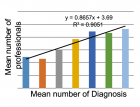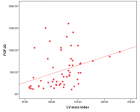Abstract
Research Article
The validity of progesterone level on hCG injection day in the prediction of IVF/ICSI cycles’ outcome
Mostafa A Abolfotouh*, Hallah Al-Anazi and Samar Hassan
Published: 11 September, 2019 | Volume 2 - Issue 2 | Pages: 095-100
Background: Previous studies highlighted the negative effect of premature progesterone elevation (PE) during IVF cycles on the cycle outcomes. The aim of this study was to assess the validity of progesterone level on hCG day (P4) in the prediction of IVF/ICSI cycles’ outcome.
Methods: In a retrospective cohort study, all fresh cycles of 256 patients who underwent IVF or ICSI cycles in 2017 at reproductive endocrinology & infertility unit/ Obg/Gyn department at King Abdulaziz Medical city, Riyadh, Saudi Arabia, were followed up. They were started on gonadotropin medications for ovarian hyperstimulation, followed by serial transvaginal U/S and serum estrogen levels each visit. Patients having 2 or more 18mm follicles were triggered by hCG 10,000 IU and ovum pickup was done 34-36 hrs after. Data were collected on patients’ characteristics [age, BMI infertility type], cycles’ characteristics [number of follicles and endometrium thickness on hCG day, P4 and estrogen levels], rates of pregnancy and pregnancy outcomes. Receiver operating characteristic curve was applied to determine the cut-off of P4 that corresponds with a negative pregnancy test. Logistic regression analysis was used and significance was considered at p - value of ≤0.05.
Results: Pregnancy rate in the study sample was 36.7%. The mean P4 level in cycles with negative pregnancy tests was significantly higher than the mean in cycles with positive tests (p = 0.018). After adjusting for confounders, significant negative association between P4 and pregnancy rate was evident (p < 0.03). The optimum trade-off of P4 for prediction of a negative pregnancy test was 1.5nmol/L. This cut-off level had a 59% sensitivity, 51% specificity and 68% positive predictive value and 10% & 15% absolute and relative risk reductions respectively. Cycles with mean P4 of ≥1.5nmol/L were significantly associated with primary infertility (p = 0.011), lower mean BMI (p = 0.009) higher mean estrogen level (p < 0.001), lower live birth rate (p = 0.048), higher abortion rate (p = 0.039), and higher ovarian hyperstimulation rate (p = 0.027).
Conclusion: Premature elevation of progesterone level on the hCG day in IVF/ICSI cycles may have adversely impacted the pregnancy rate and pregnancy outcome. The cutoff point of 1.5nmol/L for this P4 was not valid in predicting pregnancy outcomes.
Read Full Article HTML DOI: 10.29328/journal.cjog.1001028 Cite this Article Read Full Article PDF
Keywords:
Pregnancy rate; Premature progesterone rise; Prediction: Validity; Ovarian hyper stimulation; Pregnancy outcome
References
- Hugues JN, Massé-Laroche E, Reboul-Marty J, Boîko O, Meynant C, et al. Impact of endogenous luteinizing hormone serum levels on progesterone elevation on the day of human chorionic gonadotropin administration. Fertil Steril. 2011; 96: 600-604. PubMed: https://www.ncbi.nlm.nih.gov/pubmed/21880277
- Del Castillo JL, Bousamra M, De La Fuente L, Ruiz-Balda JA, Palomo M. The impact of serum progesterone levels on the results of in vitro fertilization treatments: a literature review. JBRA Assist Reprod. 2015; 19: 141-147. PubMed: https://www.ncbi.nlm.nih.gov/pubmed/27203093
- Edelstein MC, Seltman HJ, Cox BJ, Robinson SM, Shaw RA, et al. Progesterone levels on the day of human chorionic gonadotropin administration in cycles with gonadotropin-releasing hormone agonist suppression are not predictive of pregnancy outcome. Fertil Steril. 1990; 54: 853-857. PubMed: https://www.ncbi.nlm.nih.gov/pubmed/2121554
- Silverberg KM, Burns WN, Olive Dl, Riehl RM, Schenken RS. Serum progesterone levels predict success of in vitro fertilization/embryo transfer in patients stimulated with leuprolide acetate and human menopausal gonadotropins. J Clin Endocrinol Metab. 1991; 73: 797-803. PubMed: https://www.ncbi.nlm.nih.gov/pubmed/1909704
- Bosch E, Valencia I, Escudero E, Crespo J, Simón C, et al. Premature luteinization during gonadotropin-releasing hormone antagonist cycles and its relationship with in vitro fertilization outcome. Fertil Steril. 2003; 80: 1444-1449. PubMed: https://www.ncbi.nlm.nih.gov/pubmed/14667881
- Ubaldi F, Albano C, Peukert M, Riethmüller-Winzen H, Camus M, et al. Endocrinology: subtle progesterone rise after the administration of the gonadotrophin-releasing hormone antagonist Cetrorelix in intracytoplasmic sperm injection cycles. Hum Reprod. 1996; 11: 1405-1407. PubMed: https://www.ncbi.nlm.nih.gov/pubmed/8671476
- Bosch E, Labarta E, Crespo J, Simon C, Remohi J, et al. Circulating progesterone levels and ongoing pregnancy rates in controlled ovarian stimulation cycles for in vitro fertilization: analysis of over 4000 cycles. Human reproduction. 2010; 25: 2092-2100. PubMed: https://www.ncbi.nlm.nih.gov/pubmed/20539042
- Al-Azemi M, Kyrou D, Kolibianakis EM, Humaidan P, Van Vaerenbergh I, et al. Elevated progesterone during ovarian stimulation for IVF. Reprod Biomed Online. 2012; 24: 381-388. PubMed: https://www.ncbi.nlm.nih.gov/pubmed/22377153
- Venetis CA, Kolibianakis EM, Bosdou JK, Tarlatzis BC. Progesterone elevation and probability of pregnancy after IVF: a systematic review and meta-analysis of over 60 000 cycles. Hum Reprod Update. 2013; 19: 433-457. PubMed: https://www.ncbi.nlm.nih.gov/pubmed/23827986
- Labarta E, Martínez-Conejero JA, Alamá P, Horcajadas JA, Pellicer A, et al. Endometrial receptivity is affected in women with high circulating progesterone levels at the end of the follicular phase: a functional genomics analysis. Hum Reprod. 2011; 26: 1813-1825. PubMed: https://www.ncbi.nlm.nih.gov/pubmed/21540246
- Li R, Qiao J, Wang L, Li L, Zhen X, et al. MicroRNA array and microarray evaluation of endometrial receptivity in patients with high serum progesterone levels on the day of hCG administration. Reprod Biol Endocrinol. 2011; 9: 29. PubMed: https://www.ncbi.nlm.nih.gov/pubmed/21375772
- Haouzi D, Bissonnette L, Gala A, Assou S, Entezami F, et al. Endometrial receptivity profile in patients with premature progesterone elevation on the day of HCG administration. BioMed Res Int. 2014; 2014. PubMed: https://www.ncbi.nlm.nih.gov/pmc/articles/PMC4022194/
- Schoolcraft W, Sinton E, Schlenker T, Huynh D, Hamilton F, et al. Lower pregnancy rate with premature luteinization during pituitary suppression with leuprolide acetate. Fertil Steril. 1991; 55: 563-566. PubMed: https://www.ncbi.nlm.nih.gov/pubmed/1900481
- Xu B, Li Z, Zhang H, Jin L, Li Y, et al. Serum progesterone level effects on the outcome of in vitro fertilization in patients with different ovarian response: an analysis of more than 10,000 cycles. Fertil Steril. 2012; 97: 1321-1327. PubMed: https://www.ncbi.nlm.nih.gov/pubmed/22494924
- Papanikolaou EG, Pados G, Grimbizis G, Bili E, Kyriazi L, et al. GnRH-agonist versus GnRH-antagonist IVF cycles: is the reproductive outcome affected by the incidence of progesterone elevation on the day of HCG triggering? A randomized prospective study. Hum Reprod. 2012; 27: 1822-1828. PubMed: https://www.ncbi.nlm.nih.gov/pubmed/22422777
- Ochsenkühn R, Arzberger A, von Schönfeldt V, Gallwas J, Rogenhofer N, et al. Subtle progesterone rise on the day of human chorionic gonadotropin administration is associated with lower live birth rates in women undergoing assisted reproductive technology: a retrospective study with 2,555 fresh embryo transfers. Fertil Steril. 2012; 98: 347-354. PubMed: https://www.ncbi.nlm.nih.gov/pubmed/22633265
- Huang CC, Lien YR, Chen HF, Chen MJ, Shieh CJ, et al. The duration of pre-ovulatory serum progesterone elevation before hCG administration affects the outcome of IVF/ICSI cycles. Hum Reprod. 2012; 27: 2036-2045. PubMed: https://www.ncbi.nlm.nih.gov/pubmed/22561057
- Huang PC, Chen MJ, Guu HF, Yi YC, Ho JY, et al. Effect of premature serum progesterone rise on embryo transfer outcomes and the role of blastocyst culture and transfer in assisted reproductive technology cycles with premature progesterone rise. Taiwan J Obstet Gynecol. 2015; 54: 641-646. PubMed: https://www.ncbi.nlm.nih.gov/pubmed/26700978
- Ashmita J, Vikas S, Swati G. The impact of progesterone level on day of hCG injection in IVF Cycles on clinical pregnancy rate. J Hum Reprod Sci. 2017; 10: 265-270. PubMed: https://www.ncbi.nlm.nih.gov/pubmed/29430153
- Mascarenhas M, Kamath MS, Chandy A, Kunjummen AT. Progesterone/estradiol ratio as a predictor in the ART cycles with premature progesterone elevation on the day of hCG trigger. J Reprod Infertil. 2015; 16: 155-161. PubMed: https://www.ncbi.nlm.nih.gov/pubmed/26913234
- Elnashar AM. Progesterone rise on the day of HCG administration (premature luteinization) in IVF: an overdue update. J Assist Reprod Genet. 2010; 27: 149-155. PubMed: https://www.ncbi.nlm.nih.gov/pubmed/20177771
- Papanikolaou EG, Kolibianakis EM, Pozzobon C, Tank P, Tournaye H, et al. Progesterone rise on the day of human chorionic gonadotropin administration impairs pregnancy outcome in day 3 single-embryo transfer, while has no effect on day 5 single blastocyst transfer. Fertil Steril. 2009; 91: 949-952. PubMed: https://www.ncbi.nlm.nih.gov/pubmed/17555751
- Andersen AN, Devroey P, Arce JC. Clinical outcome following stimulation with highly purified hMG or recombinant FSH in patients undergoing IVF: a randomized assessor-blind controlled trial. Human Reproduction. 2006; 21: 3217-3227. PubMed: https://www.ncbi.nlm.nih.gov/pubmed/16873892
- Kiliçdag EB, Haydardedeoglu B, Cok T, Hacivelioglu SO, Bagis T. Premature progesterone elevation impairs implantation and live birth rates in GnRH-agonist IVF/ICSI cycles. Arch Gynecol Obstet. 2010; 281: 747-752. PubMed: https://www.ncbi.nlm.nih.gov/pubmed/19862542
- Kyrou D, Al-Azemi M, Papanikolaou EG, Donoso P, Tziomalos K, et al. The relationship of premature progesterone rise with serum estradiol levels and number of follicles in GnRH antagonist/recombinant FSH-stimulated cycles. Eur J Obstet Gynecol Reprod Biol. 2012; 162: 165-168. PubMed: https://www.ncbi.nlm.nih.gov/pubmed/22425288
Figures:

Figure 1
Similar Articles
-
Managing epileptic women in pregnancySarmad Muhammad Soomar*,Saima Rajpali. Managing epileptic women in pregnancy. . 2019 doi: 10.29328/journal.cjog.1001015; 2: 001-002
-
The validity of progesterone level on hCG injection day in the prediction of IVF/ICSI cycles’ outcomeMostafa A Abolfotouh*,Hallah Al-Anazi,Samar Hassan. The validity of progesterone level on hCG injection day in the prediction of IVF/ICSI cycles’ outcome. . 2019 doi: 10.29328/journal.cjog.1001028; 2: 095-100
-
Oral Clindamycin and Metronidazole in the treatment of bacterial vaginosis in pregnant black women: Comparison of efficacy and pregnancy outcomeIjeoma CC*,Nyengidiki TK,Bassey G,Ogu RN,Alegbeleye JO,Wariso KT. Oral Clindamycin and Metronidazole in the treatment of bacterial vaginosis in pregnant black women: Comparison of efficacy and pregnancy outcome. . 2020 doi: 10.29328/journal.cjog.1001040; 3: 001-006
-
Pregnancy complicated with deficiency of antithrombin: Review of current literatureMiroslava Gojnic,Zoran Vilendecic,Stefan Dugalic,Igor Pantic,Jovana Todorovic,Milan Perovic,Mirjana Kovac,Irena Djunic,Predrag Miljic,Jelena Dotlic*. Pregnancy complicated with deficiency of antithrombin: Review of current literature. . 2020 doi: 10.29328/journal.cjog.1001059; 3: 103-108
-
Endometrial thickness and frozen thaw embryo transfer: A prospective studyMahalakshmi S,Sakthi A,Saravanan L,Sharma Nidhi*. Endometrial thickness and frozen thaw embryo transfer: A prospective study. . 2020 doi: 10.29328/journal.cjog.1001066; 3: 132-135
-
Synergistic interactions of sperm impairing bacteria: Impact on pregnancy outcome in mouse modelIsheeta Jangra,Aditi Chauhan,Vijay Prabha*. Synergistic interactions of sperm impairing bacteria: Impact on pregnancy outcome in mouse model. . 2021 doi: 10.29328/journal.cjog.1001083; 4: 033-039
-
Impact of various PCOS phenotypes on oocyte competence in an ART cycleNamita Jain*,Sonia Malik,Ved Prakash. Impact of various PCOS phenotypes on oocyte competence in an ART cycle. . 2022 doi: 10.29328/journal.cjog.1001110; 5: 067-071
-
Detrimental Effects of Methylenetetrahydrofolate Reductase (MTHFR) Gene Polymorphism on Human Reproductive Health: A ReviewVandana Rai*,Pradeep Kumar. Detrimental Effects of Methylenetetrahydrofolate Reductase (MTHFR) Gene Polymorphism on Human Reproductive Health: A Review. . 2025 doi: 10.29328/journal.cjog.1001182; 8: 007-014
Recently Viewed
-
Sinonasal Myxoma Extending into the Orbit in a 4-Year Old: A Case PresentationJulian A Purrinos*, Ramzi Younis. Sinonasal Myxoma Extending into the Orbit in a 4-Year Old: A Case Presentation. Arch Case Rep. 2024: doi: 10.29328/journal.acr.1001099; 8: 075-077
-
Timing of cardiac surgery and other intervention among children with congenital heart disease: A review articleChinawa JM*,Adiele KD,Ujunwa FA,Onukwuli VO,Arodiwe I,Chinawa AT,Obidike EO,Chukwu BF. Timing of cardiac surgery and other intervention among children with congenital heart disease: A review article. J Cardiol Cardiovasc Med. 2019: doi: 10.29328/journal.jccm.1001047; 4: 094-099
-
Advancing Forensic Approaches to Human Trafficking: The Role of Dental IdentificationAiswarya GR*. Advancing Forensic Approaches to Human Trafficking: The Role of Dental Identification. J Forensic Sci Res. 2025: doi: 10.29328/journal.jfsr.1001076; 9: 025-028
-
Scientific Analysis of Eucharistic Miracles: Importance of a Standardization in EvaluationKelly Kearse*,Frank Ligaj. Scientific Analysis of Eucharistic Miracles: Importance of a Standardization in Evaluation. J Forensic Sci Res. 2024: doi: 10.29328/journal.jfsr.1001068; 8: 078-088
-
Toxicity and Phytochemical Analysis of Five Medicinal PlantsJohnson-Ajinwo Okiemute Rosa*, Nyodee, Dummene Godwin. Toxicity and Phytochemical Analysis of Five Medicinal Plants. Arch Pharm Pharma Sci. 2024: doi: 10.29328/journal.apps.1001054; 8: 029-040
Most Viewed
-
Evaluation of Biostimulants Based on Recovered Protein Hydrolysates from Animal By-products as Plant Growth EnhancersH Pérez-Aguilar*, M Lacruz-Asaro, F Arán-Ais. Evaluation of Biostimulants Based on Recovered Protein Hydrolysates from Animal By-products as Plant Growth Enhancers. J Plant Sci Phytopathol. 2023 doi: 10.29328/journal.jpsp.1001104; 7: 042-047
-
Sinonasal Myxoma Extending into the Orbit in a 4-Year Old: A Case PresentationJulian A Purrinos*, Ramzi Younis. Sinonasal Myxoma Extending into the Orbit in a 4-Year Old: A Case Presentation. Arch Case Rep. 2024 doi: 10.29328/journal.acr.1001099; 8: 075-077
-
Feasibility study of magnetic sensing for detecting single-neuron action potentialsDenis Tonini,Kai Wu,Renata Saha,Jian-Ping Wang*. Feasibility study of magnetic sensing for detecting single-neuron action potentials. Ann Biomed Sci Eng. 2022 doi: 10.29328/journal.abse.1001018; 6: 019-029
-
Pediatric Dysgerminoma: Unveiling a Rare Ovarian TumorFaten Limaiem*, Khalil Saffar, Ahmed Halouani. Pediatric Dysgerminoma: Unveiling a Rare Ovarian Tumor. Arch Case Rep. 2024 doi: 10.29328/journal.acr.1001087; 8: 010-013
-
Physical activity can change the physiological and psychological circumstances during COVID-19 pandemic: A narrative reviewKhashayar Maroufi*. Physical activity can change the physiological and psychological circumstances during COVID-19 pandemic: A narrative review. J Sports Med Ther. 2021 doi: 10.29328/journal.jsmt.1001051; 6: 001-007

HSPI: We're glad you're here. Please click "create a new Query" if you are a new visitor to our website and need further information from us.
If you are already a member of our network and need to keep track of any developments regarding a question you have already submitted, click "take me to my Query."


















































































































































